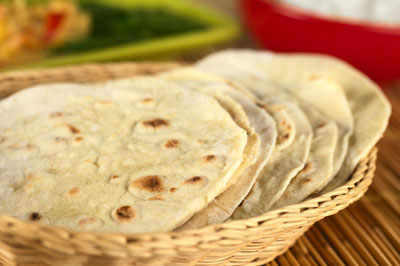
Tricks of the Trade: April 2012
April 13, 2012
By
FORMA-LAB
There are many different kinds of flatbread, with each region or ethnicity being very particular about its tastes.
The range of flatbreads you can find is very wide and depends on the clientele of every region. Various flavours are found and their use is very fickle. Here are descriptions of the most well known.
 |
|
| There are many kinds of delicious flat breads as rich in history as they are in flavour.
|
Bannock: Of Scottish origin, this bread is made by oat flakes finely ground and baked from three to five minutes. Typically bannock is eaten for breakfast or with fish (smoked salmon or pickled herring).
Berber: This bread of the North of Algeria is one of the pillars of the Berber diet and was a precious food. It is unique for its different flavours (Nigelle, fennel, figs, dates) and the mode of cooking. The Berber cooked their bread in a Tabouna, an oven in the shape of extinct volcano made on the floor with a mixture of earth and clay. We use it to make Panini sandwiches or toast for breakfast.
Chapati: Coming from the North of India and Nepal, this bread contains some flour, some salt and some warm water. The preparation takes 45 minutes and it is baked for two minutes on a heating plate. Chapati is good with spicy Indian sauces.
Ciabatta: Born in Lombardy (the North of Italy), its name means “slipper,” because of its uneven shape and the distance between its very crunchy crust and magnificently honeycombed crumb. The secret to ciabatta is its moisture content (minimum 75 per cent of the weight of the flour). Its preparation is long but the result is well worth it. Served in sandwiches, Italians are crazy about it with a good wine.
Dosa: Originating in southern India, this bread looks like a pancake and accompanies the dishes of the country. It’s cooked for two minutes on the first side and one minute on the other.
Focaccia: This flat Italian bread is often compared to pizza. The focaccia is a dough containing olive oil that we shape flat, then we spread with more olive oil and season with herbs, tomatoes, onions, hot peppers, etc. The flavours are unlimited and do not contain either sauce or meats, and rarely any cheese. Focaccia is eaten warmed and works with a cocktail or as a meal. It is excellent when made with a long fermentation (four to five hours).
Fougasse: This flatbread comes from the north of Provence in France. People often confuse fougasse and focaccia. The difference is that with fougasse, the vegetables are added and mixed in the dough. Made from the same dough as foccacia, we make it flat by cutting three or four times to create openings in the centre. Black olives or sundried tomatoes are the most popular additions. This is an excellent bread to serve with different salads.
Injera: This Ethiopian flat bread is made from Teff flour, which is milled from the smallest grain in the world, similar to millet. It is very rare in Canada and eaten as a tortilla.
Lavash: Lavash is an Armenian bread that distinguishes itself with a sweet taste of wild honey. It’s consumed with chicken or after school as snack and is baked in a 450 F oven for two minutes.
Matzoh: Hailing from Israel, this bread is made from flour and water but without yeast, salt or oil. The bread is popular for Passover, a Jewish holiday. There is a version salted for the rest of the year, which we serve with dishes in sauce.
Naan: This bread of central Asia is made using a rich dough with yogurt and sunflower or corn oil. It is shaped flat and pricked before baking. We find it round or square. The people of Afghanistan eat it with chicken.
Pita: This Lebanese bread is a low-fat pizza dough, laminated flat, fermented in a dry steam room without humidity and baked in an oven tunnel (750 to 900 F) for 25 to 35 seconds. The heat of the very hot oven provokes the formation of a ball, which brings the separation from both sides, favouring the opening of the bread to furnish it.
Pizza: The most widespread flat bread in the world, this Italian product needs no explanation. We find it everywhere and under quite different formats, for example, as plain dough, with tomato sauce, garnished, pre-cooked, as deep-frozen dough and ready to eat. Thin crust is also very popular.
Tortilla: Of Mexican origin, tortillas are very widespread and getting more and more popular. This bread is corn flour and wheat flour based. We can also make it from wheat flour only. Tortillas are cooked in a 500 F oven for 20 to 30 seconds. It is consumed with any meat or salad.
As you can see, flatbreads are ethnic in origin. The market for these breads is always growing and cannot be ignored by the traditional baker. Even though our volume is mostly sliced bread, the fact remains that it is necessary to think more and more of these varieties.
Flatbreads allow us to widen our tastes and to eat food in a different way without having to travel.
Mario Fortin is an international bakery consultant and owner of FORMA-LAB, consulting services to Bakers and Suppliers. If you need technical information, send your question to info @forma-lab.com.
Print this page
Leave a Reply